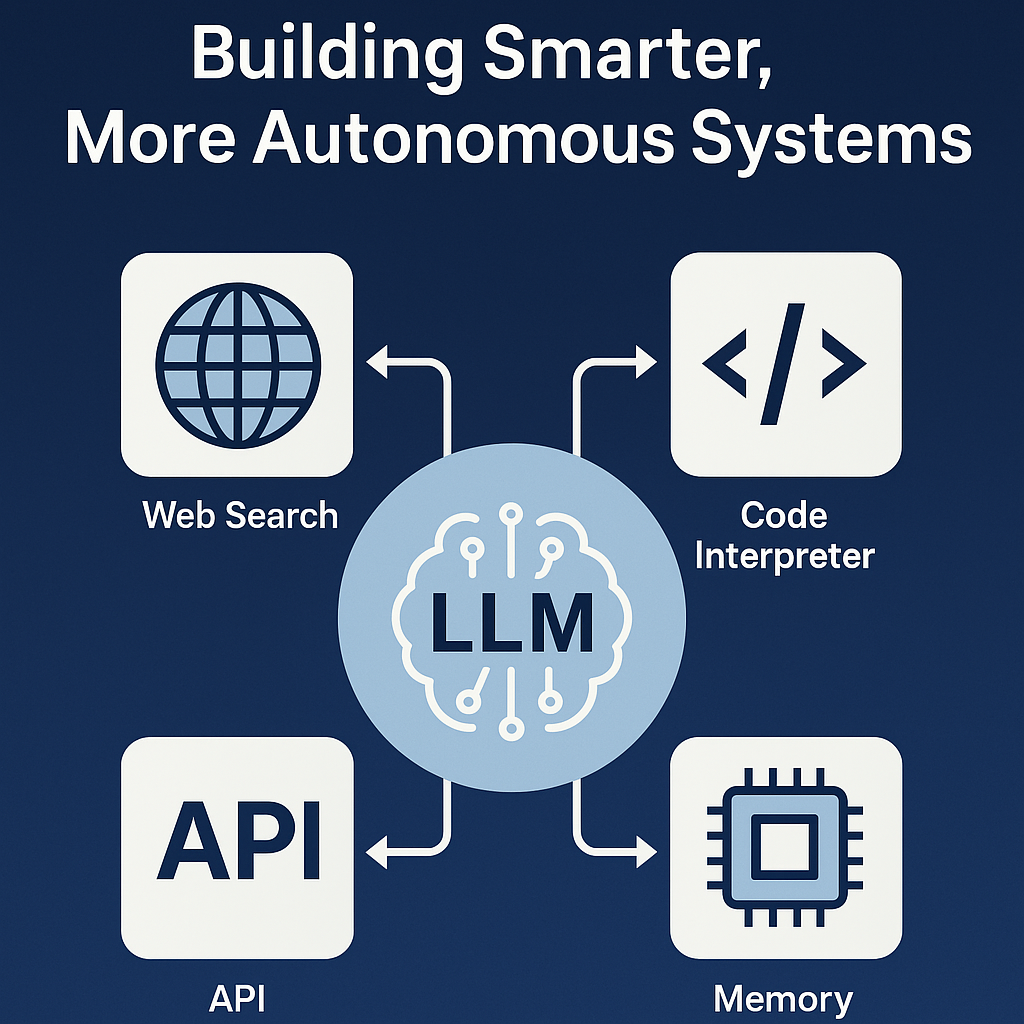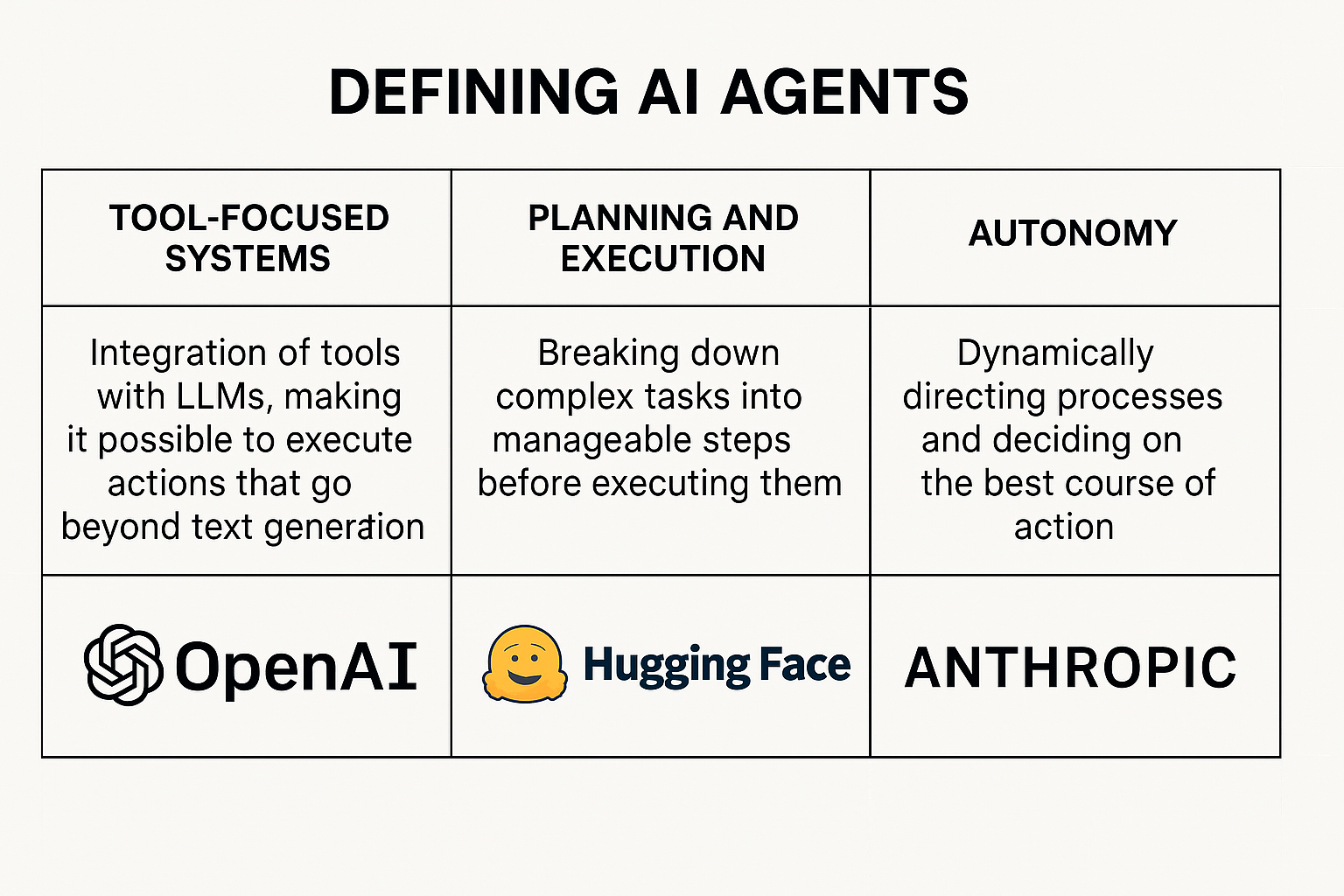The Raise of AI Agents
The landscape of artificial intelligence is rapidly evolving, and one of the most exciting developments is the emergence of AI agents. As we approach a new era where 2025 is being hailed as the year of AI agents, it’s important to understand what these systems are, and why they matter.
What Are AI Agents?
At their core, AI agents are advanced systems powered by large language models (LLMs). Unlike simple chatbots that primarily focus on text generation, AI agents are designed to interact with the real world. They do this by combining LLMs with a suite of tools—from web searches and code interpreters to API integrations and even memory systems—that provide context and real-time feedback. This integration enables AI agents to perform complex, open-ended tasks that go well beyond basic conversational exchanges.
 LLM and its connections to various tools
LLM and its connections to various tools
Defining AI Agents
There isn’t one universal definition of an AI agent; instead, leading organizations offer perspectives that highlight different aspects of these systems:
- Tool-Focused Systems: Some definitions emphasize the integration of tools with LLMs, making it possible to execute actions that go beyond text generationOpenAI.
- Planning and Execution: Other views underscore the importance of planning, where the system breaks down complex tasks into manageable steps before executing them Hugging Face.
- Autonomy: A third perspective centers on autonomy—systems that can dynamically direct their own processes and decide on the best course of action based on real-world feedback Anthropic.
These varied definitions reflect a shared belief: no matter how you define them, AI agents are marked by the central presence of an LLM, the effective use of tools, and a degree of autonomy that allows them to solve complex problems.
Key Features That Set AI Agents Apart
There are two critical aspects distinguish AI agents:
Real-World Interaction through Tool Use:
LLMs, when used on their own, are confined to their pre-training “reality.” By incorporating tools like web search and code interpreters, AI agents can step out of this bubble and engage with current, real-world data, making them far more versatile and practical.Time to Think: Test Time Compute Scaling:
Modern AI models are designed to improve with more tokens generated during inference. In essence, giving these models time to “think” and plan their responses allows them to tackle complex, multi-step problems. —
AI Agent Stages
Understanding AI agents also involves recognizing that agency isn’t a binary attribute but rather exists on a spectrum. Consider three escalating stages of agency:
Stage 1: LLM Plus Tools
This is the most basic form of an AI agent. Here, an LLM is enhanced by tools that provide additional capabilities—like running a Python code interpreter or performing a web search. While effective for simple, isolated tasks, this approach can struggle with more complex, multi-step operations.
Stage 2: LLM Workflows
At this stage, systems are built with predefined sequences or workflows where multiple LLMs and tools work in tandem. For example, an AI agent managing email might use one module for sorting messages and another for drafting responses. Breaking tasks into subtasks not only makes the system more reliable but also increases its capacity to handle varied and complex operations.
Stage 3: LLM in a Loop
At this stage the LLM receives continuous real-world feedback and iteratively refines its outputs. Imagine an AI agent that writes LinkedIn posts: it drafts content, receives feedback (e.g., ensuring the tone matches your personal style), and then revises the post accordingly until it meets all the criteria. This closed-loop approach can even extend to updating the internal parameters of the model for improved performance over time.
Design Patterns for Agentic Systems
Beyond the stages of agency, several design patterns have emerged for structuring these systems:
- Chaining: Tasks are split into sequential modules, each handling a specific part of the process.
- Routing: Systems categorize inputs and direct them to the appropriate processing module.
- Parallelization: Tasks are divided and run simultaneously (e.g., generating a response while checking compliance with policies), reducing latency.
- Orchestrator-Worker Paradigm: A planning module devises the overall strategy, while individual workers execute specific tasks.
- Evaluator-Optimizer Loop: This design involves iteratively refining outputs based on ongoing feedback until the final result meets the desired standards.
These patterns allow developers to tailor AI agents to specific applications and performance requirements, making them flexible enough to handle a wide array of tasks.
Looking Ahead: The Future of AI Agents
The potential of AI agents is enormous. By leveraging the strengths of LLMs and enhancing them with real-world tools and dynamic feedback loops, we are building systems that are not only more intelligent but also more adaptable to the complexities of real-world tasks. The journey into AI agents is just beginning, and future developments promise even more innovative applications that could revolutionize how businesses operate and how we interact with technology.
In conclusion, AI agents are transforming our approach to automation and problem-solving. By understanding their architecture and design patterns, we can better appreciate how these systems can be applied to solve real-world challenges more effectively. As we continue to refine and evolve these technologies, one thing is clear: the future of AI is both exciting and full of potential.
Happy innovating!
P.S. All the images in this post were generated with the new chatGPT 4o image generation capability

